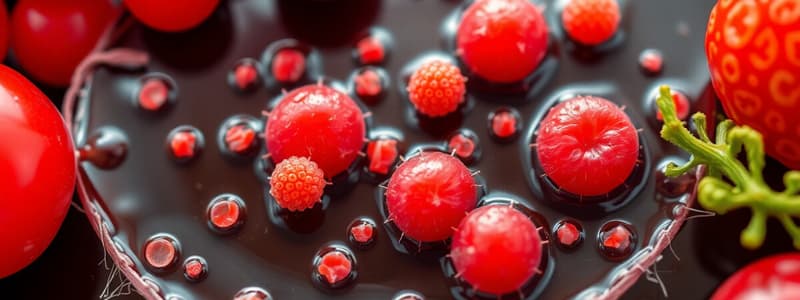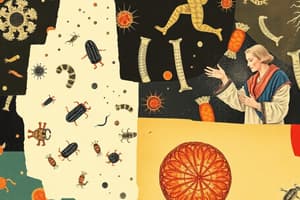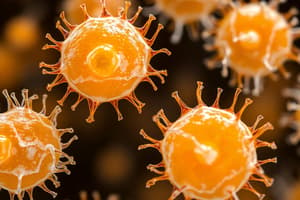Podcast
Questions and Answers
Which process involves bacteria colonizing the gut?
Which process involves bacteria colonizing the gut?
- Intoxication
- Spoilage
- Intoxification
- Infection (correct)
What does CFU stand for in the context of microbiology?
What does CFU stand for in the context of microbiology?
- Cellular Fragmentation Unit
- Cultured Fungal Unit
- Contamination Forming Unit
- Colony Forming Unit (correct)
Intoxification occurs when bacteria colonize the gut.
Intoxification occurs when bacteria colonize the gut.
False (B)
For food preparation, it is important to determine if the correct ______ are present.
For food preparation, it is important to determine if the correct ______ are present.
Match the following microorganisms with their respective examples:
Match the following microorganisms with their respective examples:
What is the pH range in which most microorganisms thrive?
What is the pH range in which most microorganisms thrive?
Acidity promotes the growth of most microorganisms.
Acidity promotes the growth of most microorganisms.
Organic acids, indicated by low ____, can minimize spoilage of food.
Organic acids, indicated by low ____, can minimize spoilage of food.
Match the following microorganisms with their preferred pH ranges:
Match the following microorganisms with their preferred pH ranges:
Which of the following preservation methods directly addresses water activity?
Which of the following preservation methods directly addresses water activity?
Salinity and water activity are unrelated factors in food preservation.
Salinity and water activity are unrelated factors in food preservation.
Food spoilage can be minimized by the presence of ____ acids, which lower the pH.
Food spoilage can be minimized by the presence of ____ acids, which lower the pH.
Match the microorganisms to their salinity preference:
Match the microorganisms to their salinity preference:
Which of the following defines a mesophile?
Which of the following defines a mesophile?
Psychrotrophs can only grow in temperatures below 0°C.
Psychrotrophs can only grow in temperatures below 0°C.
Thermophiles thrive in temperatures between _____ °C and _____ °C.
Thermophiles thrive in temperatures between _____ °C and _____ °C.
Match the microorganisms to their temperature preference:
Match the microorganisms to their temperature preference:
Where do obligate aerobes gather in a thioglycollate broth tube?
Where do obligate aerobes gather in a thioglycollate broth tube?
Aerotolerant organisms are poisoned by oxygen.
Aerotolerant organisms are poisoned by oxygen.
Microaerophiles gather in the upper part of the test tube but not the very top because they are poisoned by high concentrations of _____.
Microaerophiles gather in the upper part of the test tube but not the very top because they are poisoned by high concentrations of _____.
Match the descriptive term to the following terms describing growth in different oxygen levels:
Match the descriptive term to the following terms describing growth in different oxygen levels:
Which of the following elements is NOT a key nutritional requirement for microorganisms?
Which of the following elements is NOT a key nutritional requirement for microorganisms?
Lowering the pH of canned goods is NOT a method of food preservation.
Lowering the pH of canned goods is NOT a method of food preservation.
Storing food with a water activity less than ____ is a method to prevent microorganism growth.
Storing food with a water activity less than ____ is a method to prevent microorganism growth.
Match growth factor to the correct food preservation method:
Match growth factor to the correct food preservation method:
What is a primary limitation of using pH as the sole indicator for predicting microbial response in food preservation?
What is a primary limitation of using pH as the sole indicator for predicting microbial response in food preservation?
Spoilage of acid foods is easily detected by simple pH measurements.
Spoilage of acid foods is easily detected by simple pH measurements.
Microbial response to food preservation is not accurately predicted by pH alone because it doesn't indicate ____ acidity or the type of organic acid.
Microbial response to food preservation is not accurately predicted by pH alone because it doesn't indicate ____ acidity or the type of organic acid.
Match the following terms related to microorganisms in food
Match the following terms related to microorganisms in food
Which of the provided options is the detection and identification of microorganisms in food analysis called?
Which of the provided options is the detection and identification of microorganisms in food analysis called?
Controlling microbial growth is not important if the food contains helpful microorganisms.
Controlling microbial growth is not important if the food contains helpful microorganisms.
Food microbiologists understand which ____ can be present in a system – food require storage conditions that prevent growth.
Food microbiologists understand which ____ can be present in a system – food require storage conditions that prevent growth.
Match the methods used to identify microorganisms:
Match the methods used to identify microorganisms:
What approach involves growing organisms on a suitable media in a petri dish?
What approach involves growing organisms on a suitable media in a petri dish?
Pathogenic organisms have the same growth requirements as nonpathogenic organisms.
Pathogenic organisms have the same growth requirements as nonpathogenic organisms.
Different organisms have different growth requirements, and pathogens tend to be more _____ than nonpathogens.
Different organisms have different growth requirements, and pathogens tend to be more _____ than nonpathogens.
Match the description to the type of media:
Match the description to the type of media:
What is a method for identifying specific characteristics of bacteria?
What is a method for identifying specific characteristics of bacteria?
Enumerating only counts the amount of living microorganisms in food.
Enumerating only counts the amount of living microorganisms in food.
In enumeration, it is important to get ____ colonies and an easily countable number on the plate for accurate results.
In enumeration, it is important to get ____ colonies and an easily countable number on the plate for accurate results.
Match the method used in molecular biology for identification:
Match the method used in molecular biology for identification:
Which of the following can molecular biology identification methods accomplish?
Which of the following can molecular biology identification methods accomplish?
Titratable acidity is the use of molecular markers of an organisms for identification.
Titratable acidity is the use of molecular markers of an organisms for identification.
Identification by molecular biology makes use of the ____ of the microorganism.
Identification by molecular biology makes use of the ____ of the microorganism.
Flashcards
Microbiological analysis
Microbiological analysis
Detection and identification of microorganisms in food.
Food spoilage microbes
Food spoilage microbes
Whether microbes are present at acceptable levels.
Infection (foodborne)
Infection (foodborne)
When bacteria colonize the gut, causing illness.
Intoxication (foodborne)
Intoxication (foodborne)
Signup and view all the flashcards
Intoxification
Intoxification
Signup and view all the flashcards
Bacteria
Bacteria
Signup and view all the flashcards
Yeast
Yeast
Signup and view all the flashcards
Mold
Mold
Signup and view all the flashcards
Virus
Virus
Signup and view all the flashcards
Parasites
Parasites
Signup and view all the flashcards
Neutrophiles
Neutrophiles
Signup and view all the flashcards
Acidophiles
Acidophiles
Signup and view all the flashcards
Alkaliphiles
Alkaliphiles
Signup and view all the flashcards
Water activity (aw)
Water activity (aw)
Signup and view all the flashcards
Halophiles
Halophiles
Signup and view all the flashcards
Psychrophiles
Psychrophiles
Signup and view all the flashcards
Psychrotrophs
Psychrotrophs
Signup and view all the flashcards
Mesophiles
Mesophiles
Signup and view all the flashcards
Thermophiles
Thermophiles
Signup and view all the flashcards
Extreme Thermophiles
Extreme Thermophiles
Signup and view all the flashcards
Obligate aerobes
Obligate aerobes
Signup and view all the flashcards
Obligate anaerobes
Obligate anaerobes
Signup and view all the flashcards
Facultative anaerobes
Facultative anaerobes
Signup and view all the flashcards
Microaerophiles
Microaerophiles
Signup and view all the flashcards
Aerotolerant organisms
Aerotolerant organisms
Signup and view all the flashcards
Food preservation by pH control
Food preservation by pH control
Signup and view all the flashcards
Food preservation by water activity
Food preservation by water activity
Signup and view all the flashcards
Food preservation by salinity
Food preservation by salinity
Signup and view all the flashcards
Food preservation by temperature
Food preservation by temperature
Signup and view all the flashcards
Food preservation by atmosphere
Food preservation by atmosphere
Signup and view all the flashcards
Food Preservation and nutrients
Food Preservation and nutrients
Signup and view all the flashcards
Detecting and Identifying Microorganisms
Detecting and Identifying Microorganisms
Signup and view all the flashcards
Defined media
Defined media
Signup and view all the flashcards
Complex Media
Complex Media
Signup and view all the flashcards
Selective Media
Selective Media
Signup and view all the flashcards
Differential Media
Differential Media
Signup and view all the flashcards
Biochemical reactions
Biochemical reactions
Signup and view all the flashcards
Counting organisms
Counting organisms
Signup and view all the flashcards
Molecular Biology
Molecular Biology
Signup and view all the flashcards
Immunological
Immunological
Signup and view all the flashcards
Study Notes
Introduction to Microorganisms in Food
- Microbiological analysis involves detecting and identifying microorganisms, which is critical in food analysis.
- Ensuring the correct microbes are present is important during food preparation ;examples include Streptobacillus lactis in cheese and Acetobacter in vinegar.
- The presence of microbes at acceptable levels is important to prevent food spoilage.
- For example, Lactobacillus in milk (2 x 10^5 CFUs/mL) and E. coli in bean sprouts (5 x 10^3 CFUs/g).
- CFU stands for colony-forming unit.
- Microbes impact the shelf-life of food.
- Controlling microbial growth and extending shelf-life involves various methods.
- Foodborne diseases can result from:
- Infection, where bacteria colonize the gut.
- Intoxication, where bacteria produce a toxin.
- Intoxification, where bacteria colonize and produce a toxin.
Types of Microorganisms
- Bacteria are single-celled prokaryotes:
- Lactobacillus and some strains of E. coli are types of bacteria.
- Yeast are single-celled eukaryotes.
- Saccharomyces species are used to make beer and wine.
- Mold is a structure formed by some fungi.
- Penicillum species are a type of mold.
- Virus: infectious agent
- Norovirus can spread through foods/surfaces.
- Parasites: animals pr protozoa
- Giardia is a parasite.
Microbial Growth Requirements
- Most microorganisms are neutrophiles and prefer a neutral pH.
- Acidity inhibits the growth of most microorganisms.
- Growth ranges for microorganisms vary:
- Bacteria: pH > 4.5 (at aw of 0.85)
- Yeasts: pH > 4.0 – 4.5
- Molds: pH < 4.0
- Important acidophiles (organisms that thrive in acidic environments) include:
- Mold
- Yeasts
- Lactic acid bacteria
Controlling Food Spoilage
- Organic acids in foods like fruits, soft drinks, fermented milk products, sauerkraut, and pickles contribute to their preservation by lowering the pH.
- Organic acids are an effective way to minimize food spoilage.
Environmental Factors Affecting Microbial Growth
- Salinity is inter-related with water activity.
- Psychrophiles ("cold-loving") can grow from -20 °C to 20 °C.
- Psychrotrophs (cold-tolerant) can grow at 0 °C but prefer 20 °C – 40 °C.
- Mesophiles have an optimum growth range of 20 °C – 45 °C; they can ferment products like yogurt, cheese, wine, and beer; most human pathogens are mesophiles.
- Thermophiles ("heat-loving") tend to thrive between 50 °C and 64 °C.
- Extreme Thermophiles tend to thrive between 65 °C and 79 °C.
Impact of Atmosphere on Microbial Growth
- Bacteria (aerobic and anaerobic) can be identified by growing them in test tubes of thioglycollate broth.
- Obligate aerobes:
- Require oxygen
- Gather at the top of the tube .
- Obligate anaerobes:
- are poisoned by oxygen
- Gather at the bottom of the tube
- Facultative anaerobes:
- Grow with or without oxygen
- Gather mostly at the top
- Microaerophiles:
- Need oxygen
- Poisoned by high oxygen concentrations
- Gather in the upper part of the test tube
- Aerotolerant organisms:
- Do not require oxygen
- Not poisoned by oxygen
- Spread throughout the test tube.
Nutrients and Growth Factors
- Microorganisms require specific nutrients:
- Carbon
- Nitrogen
- Sulfur
- Phosphorous
- Methods of food preservation related to growth factors:
- pH: Acidifying foods to lower pH (e.g., canned goods below 4.6)
- Water activity: Storing food with water activity < 80.
- Salinity: Salting foods
- Temperature: Heating (pasteurization, cooking to 165 °F) or storing food in cold conditions.
- Atmosphere: Limiting oxygen for canned goods.
- Nutritional requirements:Food microorganisms can be controlled using a growth factor.
Additional Factors in Food Microbiology
- Spoilage of acid foods (pH 4.6 or lower) requires detection by cultural methods using acidified media (pH 5.0 – 5.5).
- pH is not necessarily the best indicator for predicting microbial response for preservation because it does not indicate:
- Changes in total acidity (buffering effects)
- The type of organic acid produced
- Microorganisms can lead to food spoilage or illness
- Microorganisms that cause illness are food pathogens.
- Some microorganisms are helpful in food, such as bacteria/fungi in fermented food.
- Controlling their growth and food storage is important.
- Multiple preservation methods may be needed to remove multiple growth factors for different organisms.
Detecting, Identifying, and Counting Microorganisms
- Methods to identify microorganisms in food include:
- Culturing or growing the organism
- Molecular biology testing for genetic markers
- Testing for specific immunological markers
- Specific purpose tests
- Culture methods involve a traditional approach of growing organisms on suitable media in a petri dish.
- Different organisms have different growth requirements and pathogenic organisms tend to be more fastidious than nonpathogens.
- Different medias may be required to detect different organisms
- Defined media: When all components are known
- Complex media: Use "undefined" components such as yeast extract or tryptone.
- Selective media: Only selective bacteria can grow.
- Differential: Most bacteria will grow to distinguish characteristics.
- E.g., blood agar to breakdown red blood cells
- Bacteria can take 1 to 2 days for bacteria and longer for mold and yeast to grow.
- A more recent method involves paper backed thin films of growth media (Petrifilm).
- Biochemical testing: Each organism has biochemical reactions to categorize and identify it.
- E.g., gelatinase, IMViC, fermentation of lactose
- Enumerating (counting) involves:
- Growing the organisms in a suitable medium at different dilutions.
- It is useful to get separate colonies and an easily countable, or accurate number on the plate
- The number of colonies is expressed as cfu (colony forming units).
- There is an assumption of each colony arising from a single bacteria.
Molecular and Immunological Identification
- Molecular biology identification makes use of the DNA of the microorganism and probes a specific and unique part of the genome, it can be done in a few hours.
- Immunological identification:
- Uses a unique molecular marker of the microorganism. -Requires an antibody to that marker
Other Identification Methods
- Examples of other measures related to microbial activity:
- Titratable acidity (TA) in milk
- Lactobacillus in milk produces lactic acid.
- Low levels of bacteria mean low acidity
- Acidity increases as the population increases.
- Titratable acidity (TA) in milk
Studying That Suits You
Use AI to generate personalized quizzes and flashcards to suit your learning preferences.




